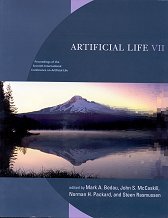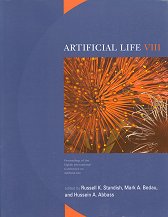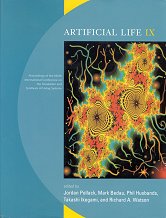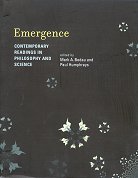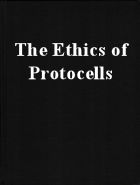The papers are gathered under the following headings: • Origin of Life, Self-Organization, and Self-Replication • Development and Differentiation • Evolutionary and Adaptive Dynamics • Robots and Autonomous Agents • Communication, Cooperation, and Collective Behavior • Methodological and Technological Applications • The Broader Context
Contents
- • Hector Fabio Restrepo, Daniel Mange, Moshe Sipper. A Self-Replicating Universal Turing Machine: From von Neumann's Dream to New Embryonic Circuits. 2000
- • Alan Dorin. Creating a Physically-based, Virtual-Metabolism with Solid Cellular Automata. 2000
- • Hiroki Sayama. Self-Replicating Worms That Increase Structural Complexity through Gene Transmission. 2000
- • Uwe Tangen. Self-Organisation in Micro-Configurable Hardware. 2000
- • Hugues Bersini. Reaction Mechanisms in the OO Chemistry. 2000
- • Pietro Speroni di Fenizio. A Less Abstract Artificial Chemistry. 2000
- • Yasuhiro Suzuki, Hiroshi Tanaka. Chemical Evolution among Artificial Proto-cells. 2000
- • Harald Huning. A Search for Multiple Autocatalytic Sets in Artificial Chemistries based on Boolean Networks. 2000
- • Ezequiel A. Di Paolo. Searching for Rhythms in Asynchronous Random Boolean Networks. 2000
- • S. Kazadi, D. Lee, R. Modi, J. Sy, W. Lue. Levels of Compartmentalization in Alife. 2000
- • Keith Downing. Exploring Gaia Theory: Artificial Life on a Planetary Scale. 2000
- • Chikara Furusawa, Kunihiko Kaneko. Complex Organization in Multicellularity as a Necessity in Evolution. 2000
- • Kunihiko Kaneko, Tetsuya Yomo. Sympatric Speciation from Interaction-induced Phenotype Differentiation. 2000
- • Hiroaki Takagi, Kunihiko Kaneko. Evolution of Genetic Code through Isologous Diversification of Cellular States. 2000
- • Thomas S. Ray, Joseph F. Hart. Evolution of Differentiation in Multithreaded Digital Organisms. 2000
- • Cefn Hoile, Richard Tateson. Design by Morphogenesis. 2000
- • Alistair G. Rust, Rod Adams, Hamid Bolouri. Evolutionary Neural Topiary: Growing and Sculpting Artificial Neurons to Order. 2000
- • David G. Green, David Newth, Michael G. Kirley. Connectivity and Catastrophe---Towards a General Theory of Evolution. 2000
- • Rob Shipman, Mark Shackleton, Marc Ebner, Richard A. Watson. Neutral Search Spaces for Artificial Evolution: A Lesson from Life. 2000
- • Richard A. Watson, Torsten Reil, Jordan B. Pollack. Mutualism, Parasitism, and Evolutionary Adaptation. 2000
- • Michael L. Best. Coevolving Mutualists Guide Simulated Evolution. 2000
- • Eizo Akiyama, Kunihiko Kaneko. Evolution of Cooperation in Social Dilemma---Dynamical Systems Game Approach. 2000
- • Takaya Arita, Reiji Suzuki. Interactions between Learning and Evolution: The Outstanding Strategy Generated by the Baldwin Effect. 2000
- • Hideaki Suzuki. Evolvability Analysis: Distribution of Hyperblobs in a Variable-Length Protein Genotype Space. 2000
- • Daniel Wagenaar, Christoph Adami. Influence of Chance, History and Adaptation on Evolution in Digitalia. 2000
- • Stevan Jay Anastasoff. Ecology and Extinction---Macroevolutionary Extinction Dynamics in a Simulated Ecosystem. 2000
- • Shinichiro Yoshii, Eiichi Miyamoto, Yukinori Kakazu. Quantification of Microscopic Events in the Process of Long-Term Evolutionary Dynamics. 2000
- • Russell K. Standish. An Ecolab Perspective on the Bedau Evolutionary Statistics. 2000
- • Patricio Lerena. Mate Choice: Simple or Complex?. 2000
- • Paul Domjan. A Discussion of the Use of Artificial Life Models to Evaluate Gould's Hypothesis about Progress in Evolution. 2000
- • Tatsuo Unemi. Should Seeds Fly or Not?. 2000
- • Bernard D. Reger, Karen M. Fleming, Vittorio Sanguineti, Simon Alford, Ferdinando A. Mussa-Ivaldi. Connecting Brains to Robots: The Development of a Hybrid System for the Study of Learning in Neural Tissues. 2000
- • Stevan Jay Anastasoff. A ' Fitness Landscaping' Comparison of Evolved Robot Control Systems. 2000
- • Hod Lipson, Jordan B. Pollack. Evolving Physical Creatures. 2000
- • Edgar E. Vallejo, Ferdando Ramos. Evolving Insect Locomotion Using Non-uniform Cellular Automata. 2000
- • Maciej Komosinski, Adam Rotaru-Varga. From Directed to Open-Ended Evolution in a Complex Simulation Model. 2000
- • Masayasu Atsumi. Artificial Neural Development for Pulsed Neural Network Design---Generating Place Recognition Circuits of Animats. 2000
- • Yuichi Sato, Takashi Nagai, Hiroshi Yokoi, Takafumi Mizuno, Yukinori Kakazu. Emergent SMA-Net Robot Control by Coupled Oscillator System. 2000
- • Norman L. Johnson. Developmental Insights into Evolving Systems: Roles of Diversity, Non-Selection, Self-Organization, Symbiosis. 2000
- • Josh C. Bongard. Reducing Collective Behavioural Complexity through Heterogeneity. 2000
- • Shin I. Nishimura. Studying Attention Dynamics of a Predator in a Prey-Predator System. 2000
- • Felix Flentge, Daniel Polani, Thomas Uthmann. On the Emergence of Possession Norms in Agent Societies. 2000
- • James A. R. Marshall, Jonathan E. Rowe. Investigating the Mechanisms Underlying Cooperation in Viscous Population Multi-Agent Systems. 2000
- • Lars Kroll Kristensen. Aintz: A Study of Emergent Properties in a Model of Ant Foraging. 2000
- • Yoshiki Yamaguchi, Tsutomu Maruyama, Tsutomu Hoshino. A Co-evolution Model of Scores and Strategies in IPD Games: Toward the Understanding of the Emergence of the Social Morals. 2000
- • Norberto Eiji Nawa, Katsunori Shimohara, Osamu Katai. On the Effect of "Stock Alerts" in an Agent-Based Model of a Financial Market. 2000
- • Frederic Kaplan. Semiotic Schemata: Selection Units for Linguistic Cultural Evolution. 2000
- • Luc Steels, Pierre-Yves Oudeyer. The Cultural Evolution of Syntactic Constraints in Phonology. 2000
- • Carlo C. Maley, Stephanie Forrest. Modeling the Role of Neutral and Selective Mutations in Cancer. 2000
- • Anthony Liekens. From Individuals to Populations, Approaches to the Study of Biological Emergent Phenomena. 2000
- • Janos Albert. Towards a Comprehensive Alife-model of the Evolution of the Nervous System and Adaptive Behavior. 2000
- • M. A. Gibney, N. R. Jennings, N. J. Vriend. Market-Based Call Routing in Telecommunications Networks Using Adaptive Pricing and Real Bidding. 2000
- • Gina M. B. Oliveira, Pedro P. B. de Oliveira, Nizam Omar. Evolving Solutions of the Density Classification Task in 1D Cellular Automata, Guided by Parameters That Estimate Their Dynamic Behaviour. 2000
- • V. J. Blue, J. L. Adler. Cellular Automata Model of Emergent Collective Bi-Directional Pedestrian Dynamics. 2000
- • James Macgill. Using Flocks to Drive a Geographical Analysis Engine. 2000
- • Una-May O'Reilly, Ian Ross, Peter Testa. Emergent Design: Artificial Life for Architecture Design. 2000
- • Barry McMullin. John von Neumann and the Evolutionary Growth of Complexity: Looking Backwards, Looking Forwards. 2000
- • Seth Bullock. What Can We Learn from the First Evolutionary Simulation Model?. 2000
- • David H. Ackley. Real Artificial Life: Where We May Be. 2000
- • Ezequiel A. Di Paolo, Jason Noble, Seth Bullock. Simulation Models as Opaque Thought Experiments. 2000
- • Alvaro Moreno. Artificial Life as a Bridge between Science and Philosophy. 2000
- • J. McKenzie Alexander. Artificial Justice. 2000
- • Edmund M. A. Ronald, Moshe Sipper. Engineering, Emergent Engineering, and Artificial Life: Unsurprise, Unsurprising Surprise, and Surprising Surprise. 2000
- • Gary R. Greenfield. Art and Artificial Life---A Coevolutionary Approach. 2000
- • Eleonora Bilotta, Pietro Pantano, Valerio Talarico. Synthetic Harmonies: An Approach to Musical Semiosis by Means of Cellular Automata. 2000
- • Christa Sommerer, Laurent Mignonneau. Modeling Emergence of Complexity: The Application of Complex System and Origin of Life Theory to Interactive Art on the Internet. 2000
- • Arantza Etxeberria. Artificial Evolution: Creativity and the Possible. 2000
